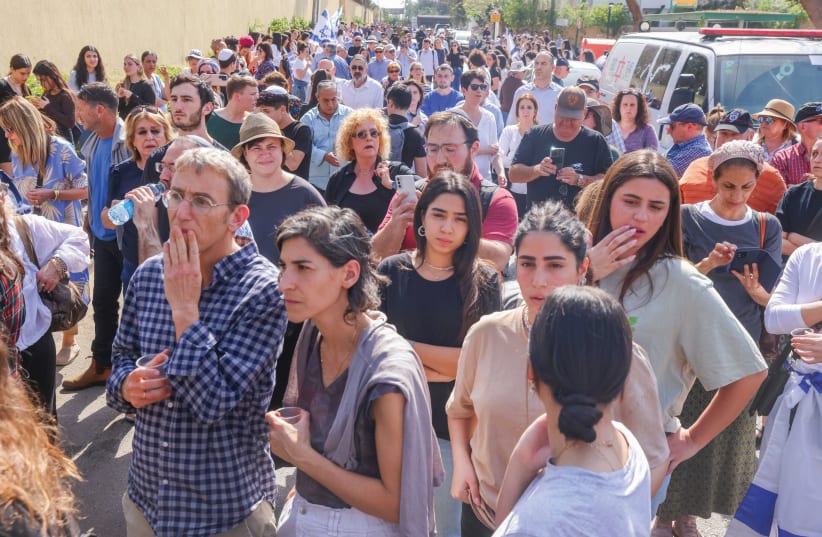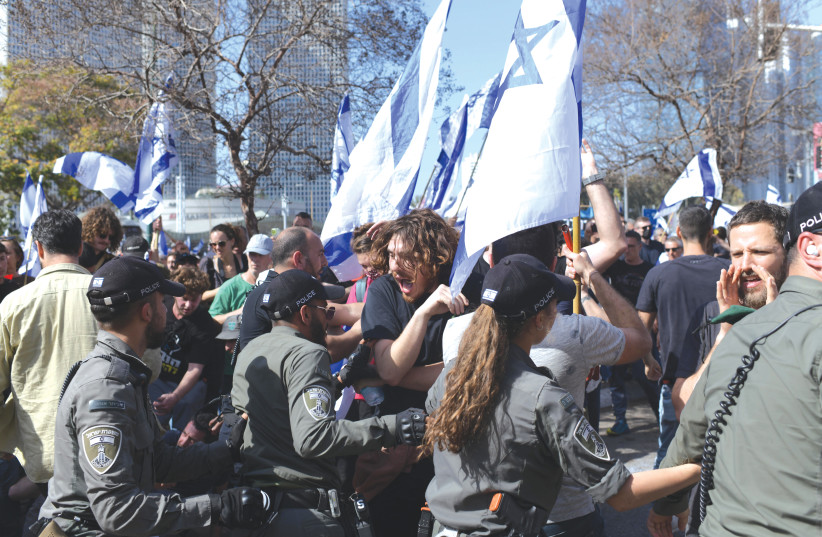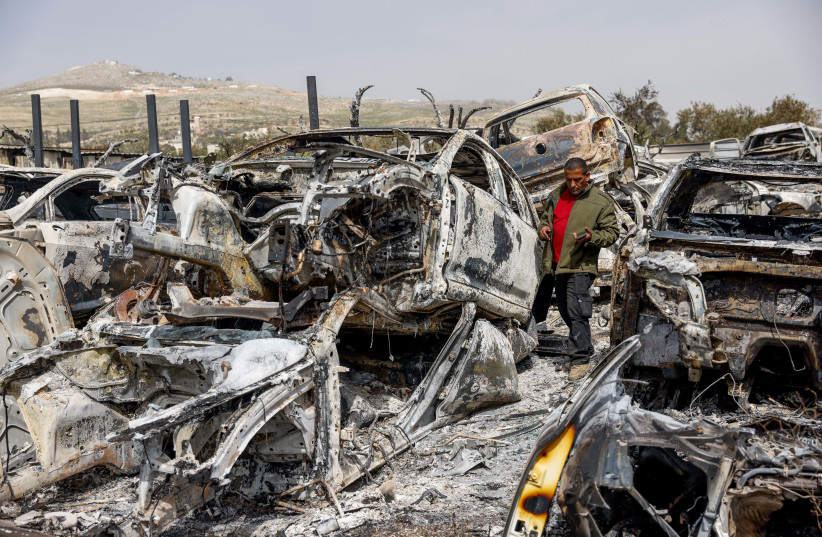Twin national traumas converged Wednesday afternoon and metaphorically created the ultimate split-screen moment.
On one side of an imaginary television screen, there could have been the chaotic scene at the “National Disruption Day” protest in Tel Aviv: the flag-waving protesters overpowering police barricades and attempting to block the country’s main road artery; the police’s forceful response, with officers on horseback, stun grenades, water cannons and dozens of arrests.
On the other side of the screen, there could have been a broadcast of the heartbreaking funeral in the Old Cemetery in Ra’anana of Elan Ganeles, murdered by Palestinian terrorists the day before as he was driving from the North through the Jordan Valley to a wedding in the Jerusalem area.
His parents and siblings eulogized him, and thousands of people – including many who did not know him – came to pay their respects in an act that some in attendance said they hoped would radiate a sense of unity during troubled times. This echoed a sentiment that Esti Yaniv said on Monday as she buried two sons – Hallel and Yagel – murdered by terrorists on Sunday in Huwara: “We are brothers. The Eternal People are not afraid of a long journey. Unity is needed.”
A metaphoric split-screen
But this split-screen moment was only metaphoric. Three television networks – Channels 11, 12, and 13 – covered the demonstration in Tel Aviv live for hours in a special broadcast. The avowedly right-wing Channel 14 broadcast the funeral in real-time. No one network juxtaposed the live coverage of both events on one split screen.
Yet, as Israel limps toward its 75th birthday celebration in less than two months’ time, the two events – this split screen – epitomize where the country is at this moment: still trying, painfully, to define itself even as it faces those trying to kill its people and destroy it.
THE PROTESTS against the judicial reform are a representation of the country – fully 75 years after its inception – still trying to figure out what it is. Is it a Jewish democratic state or a democratic Jewish state? What does it mean to be democratic? What does it mean to be Jewish? What is the right balance? How do you achieve that balance? What is the role of the legislature? What is the role of the courts?
At the core of the state’s identity, these questions should have been decided long ago, at Israel’s inception, but proved too difficult to solve.
The Declaration of Independence on May 14, 1948, stated that a Constitution should be adopted by an Elected Constituent Assembly no later than October 1, 1948. The Elected Constituent Assembly met four times before morphing into the Knesset. October 1, 1948, came and went, but no constitution was ever adopted. Because of conflicting interests, beliefs, ideologies and passions, no agreement could be reached.
So Israel did what Israel does so well: it improvised; it schlepped along on an ad hoc basis without a constitution, until it couldn’t anymore; it kicked the can down the road until the can finally hit a wall.
And that is where Israel finds itself on the eve of its 75th birthday, in front of that wall and unsure of how to kick the can past it. The coalition’s controversial judicial reform plan, the passionate opposition to the plan, the protests, “National Disruption Day” – all of that is the sound of that can hitting the wall.
A country still in self-definition mode
And while all that is playing out, while the country is very much in this self-definition mode, it still has to deal with the physical threats, which are as real as they are brutal.
Palestinians murdered three Israelis on Sunday and Monday. Terrorists have killed 14 people since the start of the year. This is more Israelis killed in two months by terrorism than were killed by terrorist attacks in all of 2019-2020. Only six times since 2009, when Prime Minister Benjamin Netanyahu returned to office, have more than 14 people been murdered by terrorists in an entire year.
This is still nowhere near the level of the Second Intifada, when there were times when 14 people were murdered in a single day, let alone in a single week or a single month. But this type of violence triggers memories – and traumas – of the Second Intifada.
This, too, has long been Israel’s fate. Building a society and defining itself, on the one hand, while simultaneously fighting to protect that society, on the other. Often it does this successfully and very well. Sometimes it does not.
The deplorable events Sunday night in Huwara where Jews set fire to cars and homes in a hate- and vengeance-filled rampage that brought shame upon the nation are one of those times writ large. Nothing justifies the burning of a village and the injury and destruction to innocents that it brings in its wake.
The pain following the killing of Hallel and Yagel Yaniv was searing. The fear that Jewish mothers and fathers who ply the road through Huwara daily and live in fear of a rock or petrol bomb thrown at them and their children while traveling to and from their homes in Har Bracha, Itamar, Yitzhar and Elon Moreh is real and ever-present.
But for that there is the state; for that there is an army; for that there is Jewish sovereignty. Jews do not – should not, must not – randomly set out to burn, kill and destroy. It is wrong. It is immoral. It is inexcusable.
It also badly confuses the chicken and the egg, as evident in this headline to a Reuters news story on the Ganeles murder: “Israeli-American motorist killed in West Bank after settlers rampage against Palestinians.”
As if this was an example of cause and effect; as if Ganeles’s murder was a result of the rampage in Huwara; as if, had there not been a rampage in Huwara, a promising 26-year-old man from Connecticut with a Zionist heart would still be alive today.
The rampage in Huwara, too, provided the country with other split-screen moments.
On one side of the screen, Jews randomly setting fire to cars, homes and businesses; on the other side IDF soldiers working with Palestinians to extract people from their burning homes. On one side of the screen, Esti Yaniv speaking with almost superhuman grace and dignity as the bodies of her two slain sons lie at her feet; on the other side, Finance Minister Bezalel Smotrich bringing opprobrium upon Israel by saying that Israel should wipe Huwara off the map.
NETANYAHU ALSO tried to create a split-screen moment of his own in peoples’ minds when he addressed the nation on Wednesday evening.
On one side of the screen, he placed the protests that day in Tel Aviv – with which he drew a false equivalence to the rampage in Huwara – and on the other screen he placed the demonstrations nearly two decades ago against the withdrawal from the Gaza Strip and the uprooting of the Gush Katif settlements.
“Twenty years ago, the debate among us was no less stormy, no less wrenching, and no less all-embracing,” he said. “An entire public that deeply opposed the government’s policy felt that its world was being destroyed.”
But, he continued, “That struggle did not cross redlines. We did not see then what we see today. Demonstrators did not strike the police, they did not call for civil disobedience, they did not call for refusal to go into the army, they did not take their money out of the country, and they did not libel the country abroad.”
There was a degree of selective memory in how Netanyahu depicted those protests.
Those protests did at times get violent, with the police using strong force against protesters and getting backing from the media, which – in general – saw the demonstrators as unjustifiably trying to block a decision made by a democratically elected government, and causing an inconvenience to the rest of the country in the process.
There were also some calls for civil disobedience and calls – not heeded in any wholesale fashion – to disobey orders or not show up for reserves. And when soldiers threatened to disobey orders or opt out of reserve duty, they were generally pilloried by an unsympathetic press.
Netanyahu added something at the end of his brief address Wednesday that is well worth remembering and which he himself would do well to keep in mind and internalize: everything that comes around goes around. Or, as Bob Dylan put it once so memorably, “The loser now/ Will be later to win,” and “The slow one now/ Will later be fast.”
Or, in the prime minister’s own words: “If redlines are erased today by one side, then tomorrow they will be erased by the other side, and the path to the total abyss is short.”
That is, if all means – including civil disobedience, disobeying orders, opting out of reserve duty, harming the economy, disrupting the nation – are legitimized today, then in 20 years those same measures could be used by the other side of the political map fighting for a cause for which it passionately believes, even at the risk of grave detriment to the country.
That ultimately corrosive dynamic is a point well worth keeping in mind.


